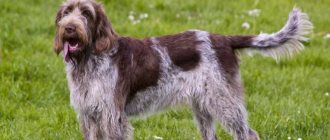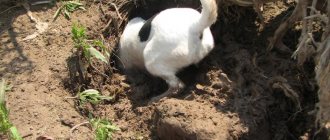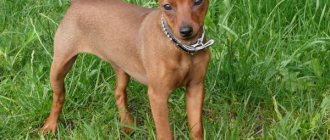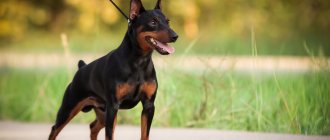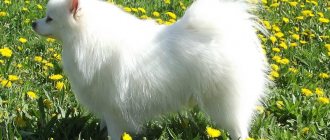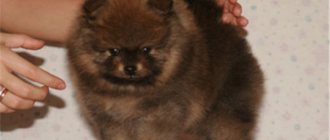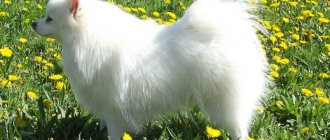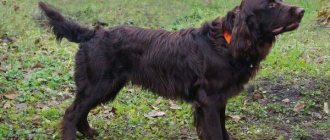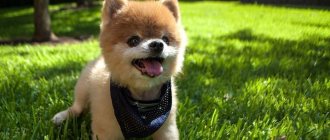This is the name given to all the varieties of dogs that the Spitz breed includes because they have many common features. These include: protruding thick fur, a tail curled up, pointed ears, a charming “smiling” face with shiny beady eyes.
The breed is extremely popular due to the miniature size of the dogs and their toy appearance. The most common types of pets are dwarf and Pomeranian. In some countries they are considered an independent variety, and in some they are classified as a dwarf breed of German Spitz.
Origin of the breed and purpose
The roots of the Spitz breed go back to the distant past, to the times of Ancient Greece and Rome. The popularity of animals peaked in the countries of Northern Europe during the Middle Ages. Although Germany is considered to be the homeland of the Spitz, breeding work was carried out:
- In Holland, Denmark, Finland.
- In Siberia, they were aimed at breeding the Spitz-shaped husky.
- Initially, breeders sought to create watchdogs called Gross Spitz dogs to protect houses, courtyards, as well as barges and ships.
- Dogs were used during hunting.
- Decorative purposes came to animals much later. By the 19th century, it had become fashionable to take classic, breed-standard miniature Spitz dogs into homes for decorative purposes.
- The process of populating noble houses with Spitz dogs proceeded quickly. The breed has a new purpose, and with it, a name (“ladies’ dogs”).
This social phenomenon in Russia was noticed by the Russian writer Anton Pavlovich Chekhov, who called his popular story “The Lady with the Dog.” The artwork has become a symbol of the purpose of the Spitz. History shows the gradual path of Spitz dogs from working dogs with a powerful physique and well-developed muscles to toy pets living on the sofas of high society living rooms. In such a situation, these cute animals continued to serve as guards. They have excellent hearing and a keen sense of smell. These properties help them smell a stranger from afar, informing their owners about this with a loud bark.
Historical fact! The trendsetter for Spitz was the English Queen Victoria, who never parted with her pet, Spitz Marco. The love for the miniature breed among people was boundless. Painters depicted them on artistic canvases, writers and poets - on the pages of fine literature.
New era
Spitz fearlessly guard their owners
But after the victory in World War II, soldiers began to bring Spitz dogs from Germany as trophies. Few could afford the luxury of keeping a decorative dog, but already in the 1950s, dog breeding gradually began to develop.
In the early 1990s, the popularity of Spitz began to increase, and promising manufacturers were imported from leading foreign nurseries. In 1996, the National Spitz Fanciers Club appeared. Currently, Russian dogs not only seriously compete with those from foreign kennels, but also often surpass them.
Advantages and disadvantages of the breed
Spitz have pros and cons of the breed, being no exception. Its advantages include:
- The animal eats little and is unpretentious to food.
- Does not freeze in severe frosts.
- The cheerful and energetic disposition of the Spitz goes well with the active lifestyle of the owner.
- Gets along easily with household members and other pets.
- Doesn't let you get bored.
- It is everyone's pet.
The breed has serious disadvantages. These include:
- As a result of selection, a small Spitz (like a bear cub), whose muzzle is made shorter and shorter by breeders, acquires respiratory pathology due to deformation of the trachea and nasopharynx.
- The excitement of the game can ruin things.
- An incredibly loud animal.
On a note! The dog is extremely sociable, so it is difficult to tolerate long separation from household members. It is undesirable to leave him at home alone for a long time, as he begins to feel sad.
Color
Thanks to its upright coat, the Spitz appears very fluffy, and its interesting color makes it incredibly attractive and unusual. By the way, the true color of the fur appears only after six months of the dog’s life. The main colors are as follows:
- White;
- Orange;
- Cream;
- Sable;
- Black;
- Brown;
- Blue.
Often the shades are mixed - unusual, unique colors are obtained, so each Spitz has an individual color with spots or streaks.
Spitz varieties
Spitz dogs come in several varieties, differing in size. At the same time, the types of Spitz differ greatly in breed characteristics. These include:
- German;
- Pomeranians;
- Japanese;
- American Eskimos;
- Italian;
- Eurasian;
- Greenlandic;
- Karelian-Finnish Laika;
- Karelian bear dog.
All varieties of this dog breed are called Spitz:
- Most of them come from the North (Siberia, the Arctic). There they were used to protect homes and transport.
- It is known from references that certain species came from Ancient Greece and Egypt.
- In the 15th century, the Miniature Spitz was bred in Pomerania.
- The Dwarf Spitzhund was created in 1450. He weighed only 9 kg. However, selective reduction in Spitz size continued.
Bred in England in the 18th century, the dwarf Spitz gained enormous popularity.
From the history of the breed! Queen Victoria of England participated in the process of selection work to develop the dwarf breed. With her light hand, the miniature Pomeranian Spitzhund acquired the image of a lap dog.
The difference between the species is the features of body proportions. The breed has almost the same body length and height. Types and names vary depending on the area of origin. In Russia, all varieties are called German, the difference is only in size. It is customary to distinguish subgroups.
| Group of animals | Large (Wolfspitz) | Medium (Middle Spitz). The group includes: Finnish, American, Eskimo, Japanese, Spitz | Small (Kleinspitz) | Pomeranian dwarf. It has three subtypes: “Bebby doll”; "Teddy Bear"; "Fox" |
| Size at withers (cm) | 50 | 40 | 29 | 10 |
The hallmarks of all dog varieties are a short neck and vertically placed paws. They also have many common features:
- A tail curled into a donut, covered with long hair.
- There is a long wool collar on the chest.
- Velvety short hair on the head.
- Black beaded eyes, slightly slanted almond cut.
- The small black nose has a rounded lobe.
- Small, triangular-shaped ears that are located almost side by side on the top of the head.
- A fox-like muzzle is located on the large skull, especially in miniature varieties of dogs.
- Rich color palette.
- A two-layer fluffy, warm coat with a long top layer and a thick undercoat.
- Straight back axis.
- The chest is different in depth.
- Legs are strong.
- Square body format.
With a large number of common features of the breed, each type of animal has its own characteristics.
German Spitz
This type is related to one of the first to begin recording time from turf dogs. The Spitz is considered a relative of the Saino Spitz, which is one of the oldest European breeds. There are several varieties of it.
| Wolfspitz (Keeshond) | Gross Spitz (Big) | Mittel Spitz (Medium) | Klein Spitz (Small) |
| A large animal, height at the withers is 55 cm. In appearance it resembles a wolf, its distant ancestor. She is mostly black in color. On the face with darkening. Used to protect the family. The dog is friendly and welcoming, can play with children and take care of them and pets. | Height at the withers ranges from 42 to 51 cm. It comes in brown, white and black. The dog is good-natured and very attached to the owner, his family and home. He is ready to protect them from danger. Has high intelligence. They use it as a companion and protector. | Height ranges from 30 to 38 cm. This is a dog that is an intermediate link between large and small Spitz representatives. Acts as a compromise when choosing if the family cannot come to a common decision on choosing a decorative friend or a huge watchman. | Height is 23-29 cm. Regardless of the dog, it performs the functions intended for it by its breed, a guard, and reacts with lightning speed to the danger that arises, filling the house with a piercing loud bark. He adores his owners, being their devoted and faithful friend. Excellent health, as well as a complete absence of hysteria in his character, are his big advantages. |
Each variety perfectly performs the duties of companions and guards. Possessing good health and good immunity, German Spitz delight their owners with their presence for 12-16 years .
Pomeranian Spitz
This variety has German roots, as it was bred in Pomerania (Germany). Pomeranians reached their highest point of adoration in England in the 19th century. Description of the Pomeranian Spitz is a miniature dog, having only 18-22 cm at the withers and 1.5-3.5 kg in weight . The appearance of oranges is charming and funny:
- They resemble fluffy balls.
- The kids have a friendly, playful character.
- Immensely energetic, always ready to play.
- The presence of high intelligence and quick wits makes them obedient to training.
- Pomeranians cannot imagine their life without the constant attention of their owner and are very attached to him.
- This decorative domestic dog belongs to the category of fidgety. She cannot sit in her arms for a long time, she constantly frolics and is on the move.
- The dog reacts very sharply to strangers. An attempt to pet him may result in loud barking, as well as a desire to bite the stranger.
The Pomeranian is a charming, funny, kind animal with the voice of a siren, devoted, faithful, and reliable in protecting the home. Its biological life span ranges from 12 to 15 years.
Japanese Spitz
The breed was first bred in Japan in the 20-3 years of the last century. Spitz originated from Samoyed Laikas as a result of their crossing with the German Spitz. The height of the animals is 38-40 cm with small sizes. Dogs have a dense and stocky build. A striking feature of the Japanese Spitz is their thick snow-white coat. The variety is characterized by cheerfulness and good nature. Spitz are great admirers of children; he plays with the kids as much as he likes with great pleasure. The dog lives from 10 to 16 years.
Note! In addition to the brilliant appearance produced by the snow-white coat, the Japanese Spitz has another very valuable quality. He barks extremely rarely. His voice does not irritate the ears of his owners.
Finnish Spitz
The breed was bred in Finland in the 19th century, at the time of its widespread distribution:
- Individuals of this species are quite large. They reach 40-50 cm. Males are somewhat larger. Their weight can be more than 10 kg .
- The character of the representatives of the variety is independent, energetic, active.
- The dogs are good-natured, attached to their owner, but they are not too diligent and loud-voiced.
Finnish Spitz are used for hunting birds and small animals. The life expectancy of dogs is from 12 to 14 years.
American Eskimo Spitz
The breed was bred in America. She is characterized by an innate distrust of strangers. The dogs are well trained and correctly carry out the owner’s commands. Dogs are man's faithful friends and have a cheerful and playful disposition. Just like German ones, they have several varieties.
| Names of varieties of American Eskimo Spitz | Standard | Miniature | Toy Spitz |
| Height (cm) | 38-49 | 32-38 | 22-30 |
Dogs are used:
- for sports;
- as detectives;
- for hunting;
- as pets.
Animals are in good health, with the exception of eye diseases. Animals live for more than 15 years.
Italian Spitz Volpino
It originated in Florence (Italy) in the 9th century, but became an independent branch by the Middle Ages:
- The size of the dogs is 25-30 cm and the weight is 5 kg .
- The Italian Spitz has long white or light hair, but there are also animals with red and fawn colors.
- The Italian Spitz has a perky temperament; it easily becomes excited, but also quickly calms down.
- These are friendly animals.
Volpino's character is restless, and he also barks too loudly and loudly. The lifespan of a Spitz is 13 years .
Eurasian Spitz
The breed was introduced in the mid-20th century by crossing a Chow Chow with a Keeshond. It is different:
- Calm disposition, restraint.
- The dog is very friendly and capable of performing protective functions.
- The Spitz will speak out when the stranger poses a real danger.
This is not only a faithful and devoted friend, but also a reliable guard. The height of the dog at the withers is 50-60 cm . The life span of a dog is 11-13 years .
Greenland dog
Animals that appeared in ancient times were intended for riding. The breed was bred in Greenland. Dogs arrived in Europe by the 30s of the 19th century. Dogs are naturally endowed with enviable endurance and courage. Sometimes they behave temperamentally and not always with restraint. Their appearance resembles classic huskies:
- They have a height of 55-60 cm .
- The dog is large and has well-developed muscles.
- Dogs vary in color.
- The dogs were intended for hunting and other work.
- The dogs were used as sled dogs.
Since this work was no longer relevant, the dog turned into the owner’s companion. The animal is very attached to members of the household and protects the house. The dog lives 12-15 years .
Karelo-Finnish Laika
Until 2009, the dogs were called "Finnish Spitz". Then they gave it its modern name. The breed was most popular during the Soviet Union. Animals are distinguished by the following characteristics:
- Dogs have high endurance, well-developed muscles, and good health.
- She reaches 42-50 cm at the withers .
- The animals have a perky, cheerful character. They perform an excellent security function, and are also loyal friends and companions.
- Laika takes part in a wild boar hunt.
The husky has a biological lifespan of 12-15 years .
Note! Parting with the owner is disastrous for this animal: the husky is a one-woman woman, all her feelings are intended only for the owner to whom she is selflessly devoted.
Karelian Bear Dog
The breed was developed in Finland. Its ancestors were ancient bear huskies. The dog must be taught to socialize, since the animal is endowed with hunting instincts. The dog is brave, unpretentious in food and lifestyle, active, playful. Shows aggression without training. The variety is distinguished by the characteristics of the breed:
- Large size (50 cm at the withers).
- The animal resembles a husky.
- Its body is oblong, less square.
- The dog has long hair and a dark color.
Excellent for performing the work of a detective, as she is endowed with intuition and a keen sense of smell. Laika is used for hunting.
The dog lives 12-14 years .
Owner reviews
The breed is not at all suitable for owners with a very busy working day. Also, Spitz will not get along with passive, phlegmatic people who do not like activity and walks. Owners cannot talk about the disadvantages of the breed, because they consider Pomeranians to be the cutest creatures.
- Kirill (Moscow):
“We bought a dog for my wife, we didn’t have any extra financial resources, so we chose it without plans for a show career. The puppy was taken without flaws, good pet class, but with a pedigree. It turned out to be a living dog that met all the characteristics of the standard. Very active, friendly, cheerful, barks loudly, and guards the apartment well. There are no problems with care, all procedures are standard, the dog tolerates bathing and haircuts. Wool, of course, falls out almost all year round, so we try to comb it more often.”
- Ekaterina (city of Kemerovo):
“We dreamed of a Spitz for a long time, we bought not the standard one, but the bear type, but this prevents him from being a super star in the city. There are absolutely no cons. A flexible, affectionate dog, he just barks loudly. Doesn't really like strangers, but quickly gets used to them, easily follows and remembers commands. We feed him dry food, pamper him with fruits and vegetables, the pet is not picky.”
- Elena (Latvia, Riga):
“My red fox is the most flexible animal, but only within the family. The Pomeranian is affectionate, kind, loves her relatives, but is jealous of all other pets and strangers. Barks frequently and reacts to all noises outside the door. She’s very cheerful and active, she runs with me in the morning, she behaves well and restrained when traveling.”
Spitz are not just little lumps that look like toys. In fact, these dogs are too active and loving; not all owners will like their pets’ excessive positivity and constant readiness to play. It is important to select a puppy not only based on external data, but also according to the breed standard of character traits.
5 / 5 ( 5 votes)
Breed standards
The animals belong to group FCI 5 (Spitz). The country of origin of the breed is Germany. The prehistoric ancestor is the turf dog. All subsequent varieties are considered Spitz due to their common roots. Main proportions: the ratio of the animal’s height at the withers to the length of the body should be 1:1.
Head:
- Average in size.
- Wedge-shaped.
- The cheeks are round and soft.
- Cheekbones are flat.
Stop: Moderately pronounced, not sharp.
Nose:
- Dark brown lobe for brown Spitz.
- Black is for other dogs.
Muzzle:
- Middle length.
- The proportion of the length of the muzzle and the skull is 2:3, 2:4.
Lips:
- With black pigmentation.
- There are no folds or bends in the corners of the mouth.
- The jaws fit tightly to the dry lips.
Teeth and bite:
- The dog has all 42 teeth.
- Scissor bite.
- The teeth are arranged vertically in the jaws.
Eyes:
- Medium-sized, almond-shaped eyes with dark irises, set obliquely.
- The eyelid shade is black in dogs of any color.
Ears:
- Placed high and close to each other.
- The small, triangular, pointed ears have hard tips.
Neck:
- The thick coat and undercoat around the neck form a collar.
- The crest of the neck is arched.
- The neck is of medium length, strong and without dewlap.
Frame:
- The neck goes into the withers, then into a straight, short back.
- It is partially covered by a curved tail.
- The strong loin is short and wide.
- The croup is wide and short, without slope.
- The deep chest with convex ribs is well developed.
- The stomach is tucked.
Tail:
- The high-set tail is of medium length.
- The tail is raised vertically from the root and curled over the back. It is densely covered with fur and presses tightly against it.
Forelegs:
- Straight legs set wide.
- Long oblique shoulder blades, muscular and dense, located at right angles to the humerus.
- A strong elbow joint that does not roll in or out and fits tightly to the chest.
- The strong, straight forearm of medium length relative to the body has scratches on the back side.
- The strong metacarpus is of medium length and has an inclination angle of 20°.
- Large front feet with arched ("cat") claws, black for any color.
Hind limbs:
- The legs are muscular, straight and parallel to each other.
- They are abundantly covered with hair up to the hocks.
- The lower leg and thigh are of equal length.
- During movement, the knees do not turn out. The hock joint is moderately strong.
- The strong, long metatarsus is set vertically.
- The hind feet have small, arched toes (“cat-like” tightly clenched toes).
- The pads are thick and dark in color.
Movement: characterized by a good push with the hind legs, they are flexible, free, and straight.
Skin: tightly stretched, does not form folds.
Wool:
- The coat has two layers: straight, long hair and a thick undercoat.
- On the head, ears, hind and forelimbs there is velvety, thick, short hair.
- The shoulders and neck are crowned with a lush “mane”.
- The forelimbs are decorated with thick feathers. The hind legs, from the hocks to the croup, have “pants.” The tail is distinguished by lush hair.
Color: Spitz can have all types of colors, but for certain varieties they are strictly defined.
In accordance with the standard, all representatives of the breed must have a weight and height that meets the standard. Any deviations are considered as its shortcomings.
Lifespan
The Spitz breed is distinguished by good immunity and good health. If the animal is provided with normal nutrition, maintenance, and care, it will be able to live its allotted life without problems or illnesses. Spitz live from 10 to 15 years.
Spitz character
These animals do not create problems by performing various functions. Their pretty faces, cheerful disposition, excellent hunting and guarding qualities delight their owners. However, when planning to get a Spitz, you need to clarify the characteristics of the breed:
- Spitz have a cheerful, playful, mischievous character.
- They are characterized by energy, activity, and restlessness.
- Some varieties of the breed are distinguished by their sonorous bark.
- Others need early training, education and training so that the animal learns to trust people and behave correctly in human society.
- If training and training are carried out incorrectly, the dog can turn into a selfish and aggressive individual.
- If the training was carried out correctly, it will become a loyal friend to its owner and a good guard. The Spitz breed is a monogamous breed, attached to one owner.
- They cannot stand loneliness and need attention.
Note! Spitz dogs need to be trained systematically at puppy age, teaching them the rules of behavior in society.
Representatives of the breed are very intelligent, so they are easy to train. However, rude shouts and physical force should not be used during training. This can alienate the dog from its owner forever.
You need to train an animal using treats, affectionate words, and elements of the game. Methods must be strict, demanding, but not cruel:
- There is no need to scold the dog.
- Persistently and patiently repeat the lesson, which she will gradually remember.
- It takes about three days to complete one command.
- You should spend no more than one hour a day on the lesson.
Training and education must be ongoing so that the animal does not forget commands.
Training
Education should be done from the very first days of the dog’s appearance in the house, and it is forbidden to give any concessions; the owner is obliged to show all the rigidity and tenacity of character.
It is important to show the puppy who is in charge in the relationship and who he will have to obey. Having felt strong control, the Spitz will begin to behave docilely. Of course, you cannot do without love, that is, you need to punish and reprimand only for offenses. Once you stop the dog from barking, the pet must understand that this way he will not achieve anything.
The best option for training would be group classes with a dog handler and other dogs, so the Spitz will not only receive high-quality education, but also experience socialization with other animals and people.
Commands necessary to learn in the first months of life:
- "ugh";
- "to me";
- "near";
- "place"
- "sit".
The Pomeranian Spitz has a sharp mind, so training will not cause much trouble, the main thing is to interest him.
Care and hygiene
Dogs need constant care and certain living conditions. Ideal conditions for dogs if they live in a house with a garden plot, so that there is an opportunity to realize the lack of physical activity:
- It is important to walk your Pomeranian every day.
- Wool is combed once a week.
- Spitz dogs are bathed once every 2 months
- Clean your ears.
Machine shearing of an animal's fur is not recommended as it will grow very slowly after clipping. The undercoat cannot be cut any more. Dogs are groomed to maintain their aesthetic appearance.
Spitz food
It is better to prepare their diet together with a veterinarian, since some individuals are prone to allergic reactions. To create a diet, it is important to take into account physical activity, weight, height, and age of the dog. There are rules that must always be followed when organizing food for Spitz dogs. There are foods that are harmful to their body. They can reduce the absorption of essential substances and cause injury to the digestive system.
The dog's diet must contain carbohydrates, proteins, microelements, vitamins, and fats. The diet may consist of the following products:
- meat (veal, chicken, lean beef, lamb);
- offal;
- chicken eggs;
- sea fish;
- cottage cheese, kefir;
- fruits, vegetables, herbs;
- porridge from buckwheat, rolled oats, rice.
Number of feedings per day
| Dog age (months) | 1-2 | 2-3 | 3-6 | 6-8 | 8 |
| Number of feedings per day | 6 | 5 | 3-4 | 2-3 | 2 |
The portion is determined by the state of health of the animal, the characteristics of its body, and age. If the dog has not finished eating, the portion should be reduced. If the dog licks the cup, add more. Keep fresh water constantly.
It is better to feed a puppy who is 2-3 months old low-fat meat, give him steamed vegetables, boiled yolk (1-2 times a week), feed him rice, buckwheat, cottage cheese, kefir.
If your dog is fed industrial food, it is better to choose the best product, since cheap food contains many substandard elements.
Nutrition
The classic Spitz diet is rich in calories and nutrients. Most of his diet should be of animal origin: meat, poultry and fish. Animal proteins provide the 20 essential amino acids your dog needs. Fats should also come from animal sources. For example, from chicken fat or salmon oil. Dogs do not have specific requirements for carbohydrates in their diet.
Choose a special food for small breeds that contains all nutrients in balanced amounts. Feed the animals 3 or 4 times a day.
Approximate amount of food per day, depending on activity:
- With a weight of 1 – from 24 to 31 g.
- With a weight of 1.5 kg - from 32 to 42 g.
- With a weight of 2 kg - from 40 to 53 g.
- With a weight of 2.5 kg - from 47 to 62 g.
You may need to reduce feedings to twice a day or reduce portions when your Pomeranian reaches 7 to 9 years of age.
Feed
What to feed a Pomeranian Spitz and what kind of food can he eat?
Your dog's diet should have a balance of proteins, carbohydrates, fats and vitamins. Namely, 40% proteins, 30% carbohydrates, 5% fats.
Quality food is more than a recognizable brand. Some of the most well-known brands of food are not suitable for most pets. However, here are some ingredients to look for on the label:
- Meat and meat meal. The most important ingredient in food is protein. However, not every protein will be beneficial for small breeds. Most proteins should come from real meat. This will depend on the brand you choose. Usually, the composition includes chicken or turkey. You will also find other meats such as beef, pork. Proteins should be listed by meat type (chicken, turkey, etc.). The label should not simply say “meat.” The same goes for meat flour. It should be written what kind of meat it is made from. If you see "meat meal" written on it, choose a different brand.
- Vitamins and minerals should come from natural sources such as vegetables and fruits. You can also purchase special vitamin supplements that are beneficial for older individuals.
There are a few things you should watch out for and avoid when choosing food.
- By-products. Meat by-products are food products identified as not being consumed by humans. The raw materials from which the by-product is obtained have no nutritional value and often contain spoiled or rotten meat. It may also contain plastic, polystyrene foam and other types of polymer packaging. By-products include skin, intestines and other parts that are not used for human consumption. Butchers and grocers send expired raw materials for reuse in the production of by-products.
- Artificial colors or other chemicals. Dogs are sensitive to products that contain artificial colors. If you ever see colors on the ingredient list, you should avoid that food. For example, blue 2, red 40, yellow 5 and 6 and so on. These supplements are designed to please human eyes. However, dyes can cause food allergies in your pet.
The dog loves natural homemade food. It is important to take care of the composition of nutrients in it. Include the following ingredients in your pet's diet:
- Proteins: White chicken or turkey (boneless, skinless, baked or fried), lean beef, fish (mackerel, salmon, herring, walleye, flounder), lamb, gizzards (liver, beef, or chicken) and/or pork (should not be the main source of protein).
- Vegetables: peas, carrots, spinach, zucchini, green beans, bell peppers and zucchini. You can also offer asparagus, cabbage, cauliflower and broccoli (in moderation, as these foods can cause gas in the stomach and intestines). Pumpkin can be given in moderation, but it is usually used to relieve symptoms of diarrhea.
- Grains/carbohydrates: include oatmeal, white or brown rice (unless intolerant), quinoa, potatoes.
- Fruits: blueberries, raspberries (both low in calories, high in antioxidants), strawberries, banana, cantaloupe, mango, kiwi, pear, peaches, nectarines, fresh pineapple and apple (no core, no seeds). Dogs can consume watermelon and oranges in moderation.
- Additionally: cottage cheese, white yogurt, eggs (most dogs like scrambled eggs more than boiled eggs).
If you decide to switch from dry food to homemade food, it is important to do it correctly. Changing store-bought food should be done gradually. Better consult your veterinarian.
Avoid the following foods:
- Chocolate.
- Coffee.
- Onion.
- Garlic.
- Raisin.
- Grape.
- Nuts.
- Corn.
- Bones.
- Spicy food.
If for some reason your pet does not eat for more than a day, he may be sick. Contact your veterinarian.
Health and characteristic diseases
Representatives of the Spitz breed have good immunity and good health. But there are diseases to which they are also susceptible. Diseases are unique to this breed:
- Due to their small size, dogs often suffer joint and bone injuries.
- There are cases of pathologies (underdevelopment of the pituitary gland), manifested by the appearance of extremely small dogs and even dwarfism.
- There are diseases associated with the eyes, ears, and nasopharynx.
- Dental problems, sometimes associated with malocclusion.
- Increased tearfulness due to allergies.
- Dysplasia.
- Throat diseases.
- Epilepsy.
Any pet illnesses should be addressed to a veterinarian.
Mating and birth
Spitz - males reach puberty before 9 months. Females - by 9 months, as they begin their first estrus. Which does not mean she is ready for mating. Pregnancy and childbirth in females are difficult, especially in small breeds. The reasons for the difficulties are:
- Miniature size of the breed.
- It is better to start mating for males at 12 months, and for females at 15 months.
- By this time, females have established a regular cycle.
- Animals must be adults (reaching puberty), full-fledged, healthy.
- For mating, it is necessary to create normal conditions (a favorable atmosphere, absence of stress for the animals), since this can negatively affect further pregnancy, childbirth, and offspring.
In cases of negative conditions, mating may not take place. A veterinarian should monitor the process of pregnancy and childbirth of a dog.
Important! Animals need to be prepared for mating. The male and female should not be sick. Animals should not be mated after recent exhaustion in the absence of adequate nutrition, vitamins, minerals, or if the individuals are extremely overfed.
Rules for choosing and purchasing Spitz puppies
When purchasing a Spitz, you need to first become thoroughly familiar with the information about the breed and avoid possible mistakes. It is better to buy a puppy older than 2 months. The baby's appearance must meet the following requirements:
- The coat color should be uniform.
- The baby should be active and inquisitive.
- The puppy's body is square and proportional.
- The eye beads are shiny.
- The nose is wet.
- His coat should be thick and shiny.
- You need to get a veterinary passport and pedigree for the puppy.
The price of a Spitz may vary, as it depends on the following reasons:
- from compliance with the standard;
- good pedigree;
- purity of the breed.
For a dog that does not meet these parameters (Pomeranian) you will have to pay $100, and $30,000 for an elite class puppy.
Population in Russia
Small pets were brought to Russia back in the 19th century, at the same time as America. They were started by rich representatives of the class. The kids accompanied beautifully dressed ladies at balls, walks and even cruises. Dogs were imported from Germany and England. There were practically no domestic breeders.
After the October Revolution, together with their owners, Spitz fell into disgrace and were declared a relic of the past, impractical and useless dogs.
The kids began to conquer Russia at the end of the last century. Over time, Spitz have become a part of our lives, and photos of these beautiful dogs have flooded the Internet.
Modern Pomeranians
The lifespan of these animals depends on their size. Typically ranges from 8 to 20 years. The smaller the dog, the shorter its life.

